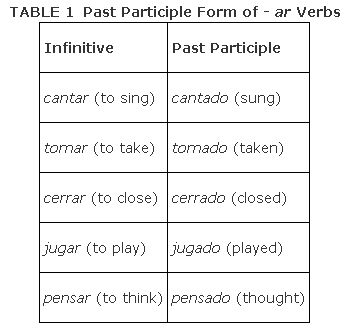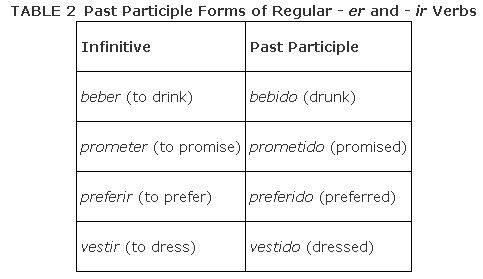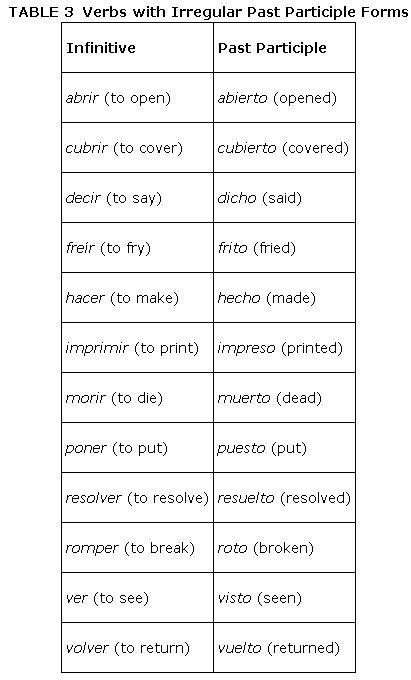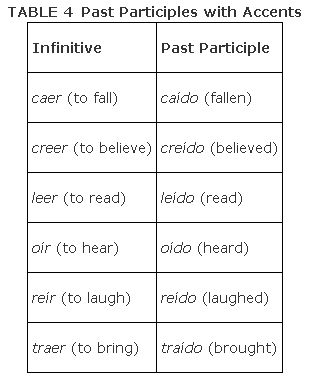Learning to recognize and use past participles will increase your Spanish language powers tremendously. The creation and use of the past participle form of the verb as well as the use of the past participle as an adjective are explained in the following sections.
No verb undergoes a stem change in its past participle form, and all ‐ar verbs have regular past participle forms. To create the past participle form of an ‐ar verb, replace the ‐ar infinitive ending with ‐ado. In the examples in Table , you may notice that the English past participle sometimes looks and sounds just like the English past tense but that the Spanish past participle form is entirely different from the past tense.

Because an English past participle is so similar to the English past tense, recognizing a past participle written in English is much more difficult than it is in Spanish. To thoroughly understand this concept, let's quickly review this point of English grammar. Most English speakers were forced to learn the past participle as one of three forms of a verb. You may remember chanting: “swim, swam, swum,” “drink, drank, drunk,” “write, wrote, written,” and “bring, brought, brought.” Can you fill in the blanks below?
Whether or not you remember the correct answers (done, taken, and thought) for these particular blanks, any memory of these verb threesomes indicates that some elementary school teacher was trying to teach you that the past tense and the past participle form of a verb may be but are not always the same. Most people chanted away without realizing that they were chanting the present tense, past tense, and past participle form of each verb. Now we confuse English past participles with the past tense because, for some verbs, the past participle form looks and sounds exactly like the past tense.
When an English verb ends in ‐ed it may be in its past participle form or in a past tense conjugation. There is only one way to know for sure that it is a past participle rather than the past tense: A past participle is always preceded by some form of the helping verb “to have” (namely, have, has, or had). For example:
- Yesterday, I wrote (past tense).
- I have written (past participle).
- Last week, I called (past tense).
- I have called (past participle) many times.
- Yesterday, he did (past tense) his homework.
- He has done (past participle) it every day.
Past participle forms never look like past tense forms in Spanish, and there are not many verbs with a past participle ending other than ‐ ido or ‐ado. The regular past participles of ‐er and ‐ir verbs are exactly alike (see Table ). The few irregularly formed past participles are listed in Table . Any ‐ ir or ‐er verb that does not appear on the irregular list has a past participle formed by removing the ‐er or ‐ir infinitive ending and replacing it with ‐ido. Remember that a Spanish past participle form never undergoes a stem change.


Table lists the 12 verbs with irregular past participle forms. Notice that most irregulars end in ‐to or ‐cho.
Many of the above verbs are also used with prefixes. The following verbs have the same past participle form (after the prefix) as the simple verbs above:
- devolver (to return something)
- rehacer (to redo, to remake)
- revolver (to turn around, to turn over)
Note: Because satisfacer (to satisfy) is always formed like hacer, its past participle is satisfecho.
To preserve the stress on the correct syllable, any verb that ends in ‐ aer, ‐eer, or ‐oír will have an accent on the í of its past participle ending (see Table ).

The following verbs with prefixes also have an accent on the ‐ído of the past participle form:
|
|
|
|
|
|
|
|
|
|
|
|
|
|
|
|
|
|
|
|
|
|
|
|
|
|
|
|
|
|
|
|
|
|
|
|
|
|
|
|
|
|
|
|
|
|
|
|
|